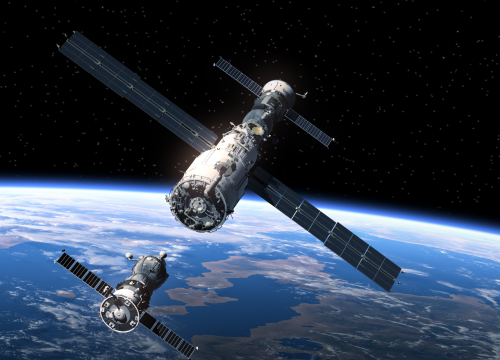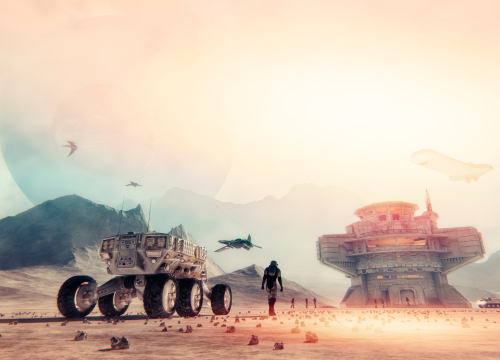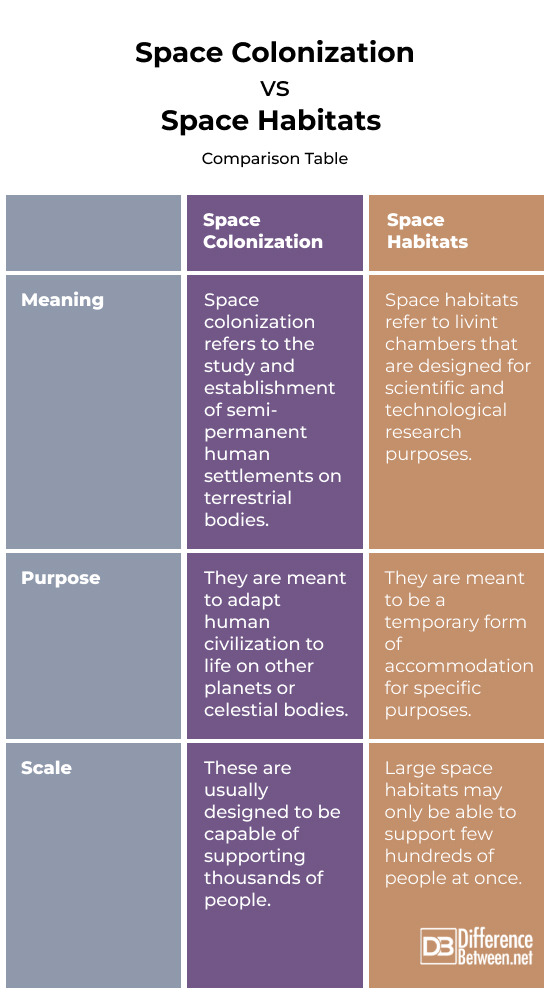Difference Between Space Colonization and Space Habitats
Over the past fifty years, human civilization has explored the countless celestial bodies outside our orbit to see if man can survive outside Earth. Space colonization and space habitats are two terms that often come up when discussing the chances of human survival in extraterrestrial habitats. But what exactly do they mean? This piece will explore the meaning, similarities, and differences between space colonization and habitats.

What is Space Colonization?
Space colonization is also known as space settlement or extraterrestrial colonization, and it refers to the study and establishment of other terrestrial bodies in space to determine if they are fit for permanent habitation by humans. The truth is that space colonization is a somewhat popular concept among space explorers and astronauts, and its application has been proposed in the past—for instance, space colonies for extraterrestrial mining activities.
However, there have been no permanent space colonies, and humans have also not legally claimed any of the extraterrestrial space around us. Why? Space colonization is restricted by international space law. According to this law, space is a common heritage. Therefore, no country or group of people is allowed to militarize or colonize space. This law also suggests international cooperation to regulate space allocation for limited spaces such as the moon or earths’s geostationary orbit.

What is a Space Habitat?
Space habitat is also referred to as a space settlement, space stead, space colony, space city, orbital habitat, orbital settlement, etc. The space habitat is a ter
used to define an advanced living chamber with more facilities than a habitation module or space station. It’s exciting to note that space habitats are designed to be a form of permanent settlement. By relying on innovative technology, these semi-permanent habitats may also be able to support plant life.
Possible Similarities Between Space Colonization and Space Habitats
While the theories of space colonization and space habitats may sound fictional, plenty of work is going on behind the scenes to make them a reality. At first, space colonization and space habitats may sound unrelated. However, when you look at their underlying concept, a few similarities are apparent. These include;
- Self-sustainability: From their definition, it’s evident that both space colonization and solace habitats are designed to ensure human survival in the void of space. To support human life in space, both aim to incorporate several self-sustainability measures. For instance, they may feature recycling and waste management systems, including facilities supporting plant life.
- Resource Management: Another notable similarity between space colonization and space habitat is their emphasis on resource management. Engineers are expected to figure out how to manage resources such as food, water, and air efficiently. It may involve the development of special tools that can extract and recycle these scarce resources.
- Space Adaptation: Furthermore, space settlements and habitats are designed to help human inhabitants survive in space. These structures would feature a microgravity or reduced gravity system. This unique adaptation may also demand medical support, physical conditioning, and psychological support.
- Technological Innovation: Considering the scale and challenges of both space settlements and habitats, it’s safe to say that both will feature innovative technology – some of which may not have been invented. Engineers must find unique solutions to propulsion, habitat design life support, and resource utilization systems.
Differences between Space Colonization and Space Habitats
While space colonization has a few similarities, they are distinct concepts. Here’s a list of notable differences between both of them:
Purpose
When you look at the definitions of both terms, it’s easy to think they are the same. However, there’s a difference in terms of their longevity. Space settlements are designed to be permanent human settlements on celestial bodies, including asteroids, moons, and other planets.
Extraterrestrial colonization aims to create a self-sustaining community that supports large populations outside Earth. This settlement would be capable of conducting economic and social activities. On the other hand, space habitats form temporary residences to provide living and working conditions in orbit or extraterrestrial areas where permanent residence is not feasible.
Degree of Autonomy
An extraterrestrial colonization is usually designed to be self-sufficient and rely on locally sourced resources for energy generation and sustenance. It aims to recreate the earth-like conditions that support agriculture, manufacturing, etc. In contrast, space habitats may focus on resupply missions back to Earth to provide limited resources.
Scale
By default, extraterrestrial colonizations are large-scale settlements that can support thousands of people at once. These colonies usually require well-designed infrastructure for housing, transportation, and governance. Space habitats may vary, but they are generally smaller than extra-terrestrial colonization. Their structures are typically designed to suit their intended purpose. For instance, they may have structured for technology development and scientific research.
Space Colonization vs. Space Habitats: Comparison Table

Summary
Space colonies and habitats may be the future of human civilization. However, there’s a long way to go. If you’re interested in finding out the difference between both terms, go through the details in this article.
FAQs
What is the meaning of space colonization?
Space colonization describes the establishment of self-sustainung human settlements on celestial bodies.
What is the difference between a space station and a space colony?
Space stations are designed for temporary use, while colonies are designed with long-term applications in mind.
What are the examples of space colonization?
Space colonization is a largely speculative concept and is yet to be implemented . However, there are several noteworthy projects including Mars colonization, lunar colonization, spaceX starship, International Space Station, etc.
Why space colonization is not feasible?
Space colonization is not currently feasible due to technology limitations, cost and health-risk of the project.
Are space colonies possible?
Space colonies are hypothetically possible. They are a speculative concept with plenty of ongoing research.
What is a space colony called?
Space colony is also called space settlement or extraterrestrial colony.
What are the pros and cons of space colonization?
Space colonization is important because it will take human civilization to another age where interstellar travel is a simple reality. However, this concept is quite costly and we still lack the technology to make it happen.
Why hasn’t Elon Musk gone to space?
Elon Musk hasn’t gone to space because his focus has been on the development and advancement of space technology rather than on personal spaceflight.
Why does Elon Musk want to colonize space?
Musk has stated that his primary goal with SpaceX is to enable human space exploration and colonization by reducing the cost of space travel through innovations in rocket technology and reusability.
- Difference Between Space Colonization and Space Habitats - May 13, 2024
- Difference Between Space Junk and Operational Satellites - May 9, 2024
- Difference Between Vector-Borne and Airborne Diseases - May 7, 2024
Search DifferenceBetween.net :
Leave a Response
References :
[0]Pelton, J. N. (2016). Space Habitats, Space Colonies and the New Space Economy. Springer EBooks, 141–157. https://doi.org/10.1007/978-3-319-39273-8_8
[1]O’Neill, G. K., & Reynolds, G. (1977). Habitats in Space. The Science Teacher, 44(6), 22–26. https://www.jstor.org/stable/24128636
[2]The Colonization of Space. (n.d.). Nss.org. https://nss.org/settlement/nasa/75SummerStudy/Chapt.1.html
[3]Image credit: https://www.canva.com/photos/MAEJKNEOr3U-space-exploration-and-planetary-colonization/
[4]Image credit: https://www.canva.com/photos/MADA7aEUlog-spacecraft-and-space-station/
